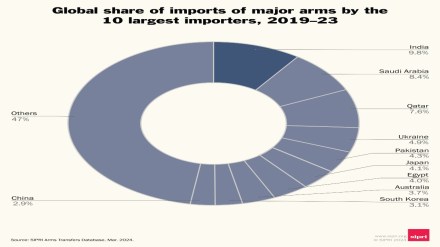India is strategically steering away from reliance on foreign defence imports and embracing self-sufficiency, epitomized by the ‘Atmanirbhar’ initiative. From drones and cannons to tanks, fighter jets, and warships, the country is witnessing a surge in indigenous production under the ‘Make in India’ campaign.
However, despite this push for self-reliance, a recent report from the Stockholm International Peace Research Institute (SIPRI) reveals that India has been the world’s largest arms importer over the past five years, shedding light on both its progress toward self-sufficiency and its ongoing reliance on global arms trade dynamics.
And, for the first time in 40 years, arms exports from Russia to India have decreased by 50 percent. Although India still buys the most arms from Russia, this figure has fallen to 36 percent of the total arms. The SIPRI report states that “This is the first time since the Soviet era of 1960-64 that Russia’s share in India’s arms imports is less than 50 percent.”
The latest report of SIPRI has come at a time when on Tuesday (March 12), Prime Minister Narendra Modi witnessed the first tri-service ‘indigenous’ military exercise of the three services of the army in Pokhran, Rajasthan. In this exercise ‘Bharat-Shakti’, the Army, Air Force and Navy will demonstrate their strength with their respective indigenous weapons. The motto of this exercise is ‘Empowerment through Indigenization’.
According to the data released by SIPRI, not only India but Asian countries have purchased the maximum number of weapons in the last five years. Russia’s dominance in the field of arms has diminished slightly, while India’s other friends France and the US have overtaken Russia in the field of arms. Russia has reached third place in terms of arms sales. Whereas the US and France have secured the first and second positions.
Though Russia is traditionally considered a big country in arms export, however, after the war with Ukraine and the imposition of various sanctions, it has lagged behind. Russia’s arms exports have fallen by 53 percent.
In the year 2019, Russia sold arms to 31 countries, but in the year 2023, only 12 countries bought arms from Russia. India has purchased 34 percent of arms from Russia. One reason for Russia’s lagging behind is that it has not upgraded its weapons with time.
Due to the Russia-Ukraine war and pressure from Western countries, Egypt also did not make a fighter jet deal with Russia. India continues to buy oil and gas from Russia on a large scale at cheap prices. One reason for Russia’s lagging behind is that due to the war, Russia is not able to supply systems like S-400 on time. Apart from France, America’s arms export has also increased by 17 percent. China is at number four.
According to SIPRI, France has become a big player in the world arms market and India also made deals with it for many arms and missiles including Rafale. India has been the biggest buyer of French arms, accounting for about 30 percent of France’s total exports. India has purchased Rafale fighter jets from France. Furthermore, as reported by Financial Express Online, India is in talks for 26 Rafale Marine jets to be procured for the Navy’s aircraft carrier INS Vikrant. In December 2023, France sent in a bid and the contract will likely be signed this year. France’s arms exports have increased by 47 percent between 2014-18 and 2019-23.
In the last five years, India has become the world’s largest arms buyer. According to SIPRI, imports into India have increased by five percent. India’s arms imports have increased by 4.7 percent between 2014-18 and 2019-23.
India’s Ranking
India ranks first in the world with 9.8 percent arms import. After India, there is Saudi Arabia which has imported 8.4percent arms. Qatar has imported 7.8percent, Ukraine 4.9percent, Pakistan 4.3percent, South Korea 3.1percent and China 2.9percent. Despite its economic situation, Pakistan has succeeded in purchasing 43percent weapons. The neighbouring Pakistan has purchased 82percent of its weapons from its ally China. Ukraine has purchased the most arms in Europe, which has been at war with Russia for the last two years. For the first time in 25 years, the US has become the largest supplier to Asia and Oceania.
